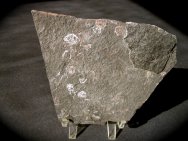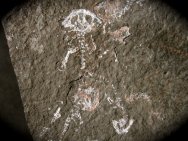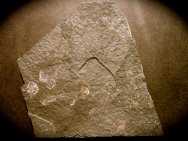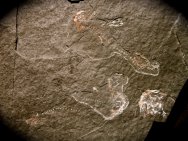Branchiosaurus
dracyiensis
(Boy 1972) Class Amphibia,
Order Temnospondyli, Family Eryopoidea
Geological
Time: Permian (about 285 mya)
Size: Fossils
range in size from 3/4” to 1 ¾”in length,
on a 5 1/2” x 5 1/4” plate
Fossil Site:
Rotiegendes Unit, Tabarz, Thuringia, Germany
Fossil Code:
PFV396
Price: Sold
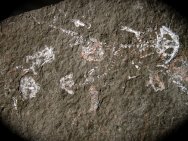 Description:
Of interest to many paleontologists are the transitional fossils
of early amphibians. These creatures needed both aquatic and
terrestrial environments to survive. My German fossil dealer
associate kindly sent me a small batch of these rare Branchiosaurus
dracyiensis amphibian fossils. These amphibians apparently come
from a mass mortality horizon. What killed them in such astounding
numbers is a mystery to me. The plate has specimens on both sides.
There are six skulls with some backbone, and a few with some
backbone and limb structures. Some residual body part hash is
also preserved. The unusual white and muted purple colored specimens
contrast well against the dark colored matrix. Description:
Of interest to many paleontologists are the transitional fossils
of early amphibians. These creatures needed both aquatic and
terrestrial environments to survive. My German fossil dealer
associate kindly sent me a small batch of these rare Branchiosaurus
dracyiensis amphibian fossils. These amphibians apparently come
from a mass mortality horizon. What killed them in such astounding
numbers is a mystery to me. The plate has specimens on both sides.
There are six skulls with some backbone, and a few with some
backbone and limb structures. Some residual body part hash is
also preserved. The unusual white and muted purple colored specimens
contrast well against the dark colored matrix.
Branchiosaurus is a genus of small, lightly built early prehistoric
amphibians. Fossils have been discovered in strata dating from
the late Pennsylvanian Epoch to the Permian Period. This tiny amphibian
was very similar to the Rachitomi, differing primarily in size.
The
first major groups of amphibians developed in the Devonian period
from lobe-finned fish similar to the modern coelacanth and
lungfish, which had evolved multi-jointed leg-like fins that enabled
them to crawl along the sea bottom. Some fish had developed primitive
lungs to help them breathe air when the stagnant pools of the Devonian
swamps were lacking in oxygen. They could also use their strong
fins to hoist themselves out of the water and onto dry land if
circumstances required it. Eventually, their bony fins would evolve
into limbs and they would become the ancestors to all tetrapods,
including amphibians, reptiles, birds, and mammals. Despite being
able to crawl on land, many of these prehistoric tetrapodomorph
fish still spent most of their time in the water. Amphibians evolved
adaptations which allowed them to stay out for longer periods.
However, they never developed the ability to live their entire
lives on land, having a fully aquatic tadpole stage and still needing
to return to water to lay their shell-less eggs.
|
|

